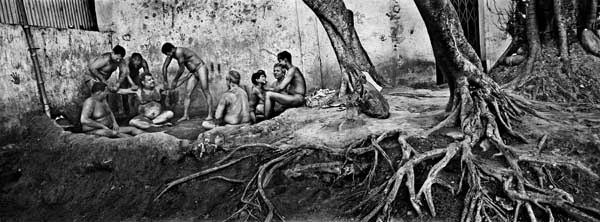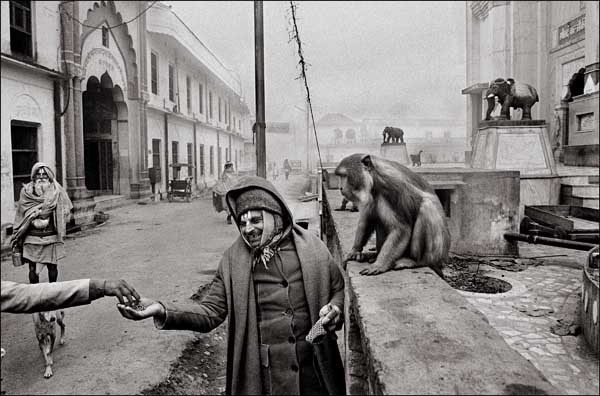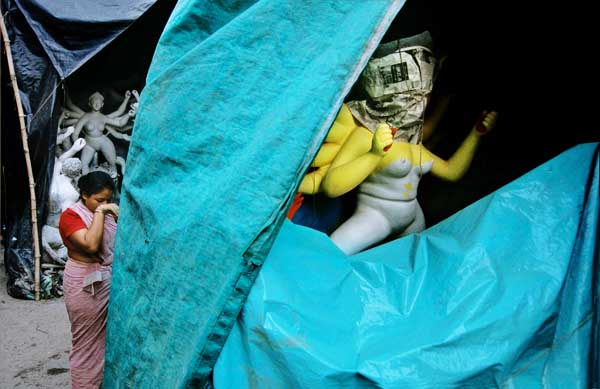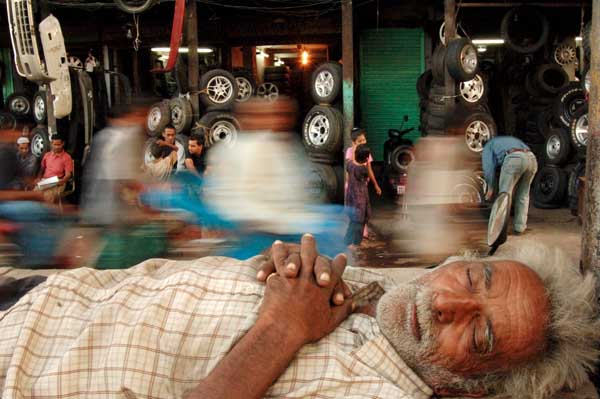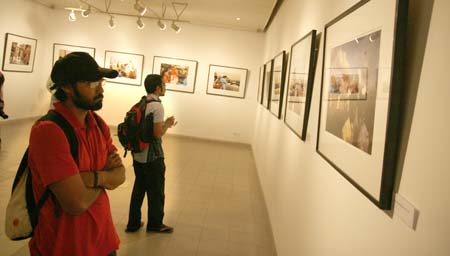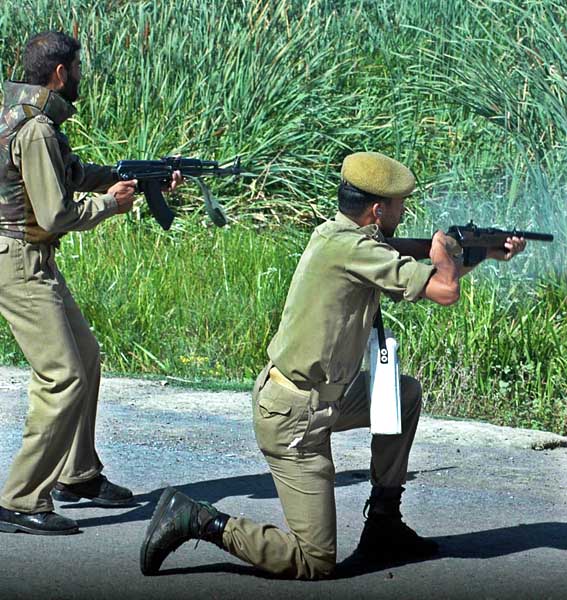Tushikur Rahman - Finalist for Emerging Photographer Grant 2011
Fatalistic Tendency play this essay on burn magazine There is a place in which your privacy, intimacy, integrity and inviolability are guaranteed. Your own body and mind, that unique temple and a familiar territory of sense and personal history.
Anxiety and stress can cause sleep deprivation, warping space and time, ultimately leading to fatalistic tendencies.
If one wishes to commit suicide, one gradually loses his mental resilience and sense of freedom? Feeling alien and objectified ? unable to communicate, relate, attach or empathize with others? Floating in dreams and eventually fleeting in the sky? The taste of suicide: the true sensation, the extreme fantasy.
I could never write a diary; thinking about the things which should be written in a personal diary was the most difficult part for me. Making this photo story was like writing a personal diary about my past, and feeling the same kind of difficulty. Thinking about those times is still hard for me.
There is a place in which your privacy, intimacy, integrity and inviolability are guaranteed. Your own body and mind, that unique temple and a familiar territory of sense and personal history.
Anxiety and stress can cause sleep deprivation, warping space and time, ultimately leading to fatalistic tendencies.
If one wishes to commit suicide, one gradually loses his mental resilience and sense of freedom? Feeling alien and objectified ? unable to communicate, relate, attach or empathize with others? Floating in dreams and eventually fleeting in the sky? The taste of suicide: the true sensation, the extreme fantasy.
I could never write a diary; thinking about the things which should be written in a personal diary was the most difficult part for me. Making this photo story was like writing a personal diary about my past, and feeling the same kind of difficulty. Thinking about those times is still hard for me.
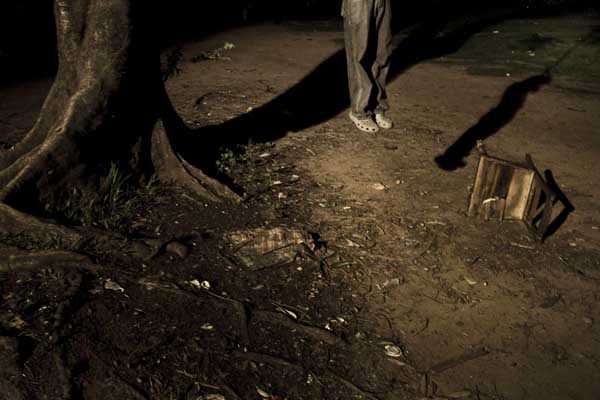 This work has been published before in Viewbook Photostory 2010-Yearbook and WPO (World Photography Oranization) 2011, Student Focus Award.
Bio
Tushikur Rahman, born in Bangladesh in 1987 is a documentary photographer who prefers to work with social issues both urban and rural. In 2009, Tushik enrolled in Pathshala South Asian Media Academy for BA in Photography. He participated in various international workshops conducted by renowned teachers and practitioners including Stuart Freedman, Jorge Villacorta, Shannon Lee Castleman, Abir Abdullah and Munem Wasif. He is also devoted in travelling and capturing thrilling subjects including the lives of Tiger widows and a full sequence of a tiger being slaughtered by hundreds of people in Shatkhira, Bangladesh. In 2010, he finished his latest project, Fatalistic tendency, a deep subject concerned with depression that results in violence. In 2010, he received 3rd prize of Jury award in conceptual category of prestigious Viewbook Photostory, Slected as a finalist for the WPO-World Photography Organization Student focus award 2011.
Related links
www.lightstalkers.org/tushikur-rahman
The above article has been published on the burn magazine website,? at http://www.burnmagazine.org/epf-2011-finalists/2011/05/tushikur-rahman-fatalistic-tendency/
This work has been published before in Viewbook Photostory 2010-Yearbook and WPO (World Photography Oranization) 2011, Student Focus Award.
Bio
Tushikur Rahman, born in Bangladesh in 1987 is a documentary photographer who prefers to work with social issues both urban and rural. In 2009, Tushik enrolled in Pathshala South Asian Media Academy for BA in Photography. He participated in various international workshops conducted by renowned teachers and practitioners including Stuart Freedman, Jorge Villacorta, Shannon Lee Castleman, Abir Abdullah and Munem Wasif. He is also devoted in travelling and capturing thrilling subjects including the lives of Tiger widows and a full sequence of a tiger being slaughtered by hundreds of people in Shatkhira, Bangladesh. In 2010, he finished his latest project, Fatalistic tendency, a deep subject concerned with depression that results in violence. In 2010, he received 3rd prize of Jury award in conceptual category of prestigious Viewbook Photostory, Slected as a finalist for the WPO-World Photography Organization Student focus award 2011.
Related links
www.lightstalkers.org/tushikur-rahman
The above article has been published on the burn magazine website,? at http://www.burnmagazine.org/epf-2011-finalists/2011/05/tushikur-rahman-fatalistic-tendency/
Interview of Shahidul Alam on Ekushey TV
5:25 pm on Saturday 22nd May 2010 on Ekushey'r Shondha
Raghu Rai's "India" at Bengal Gallery
7 September 2009.?Exhibition Opening: 11am
Bengal Gallery Of Fine Arts
House 275/F, Road 27, Dhanmondi, Dhaka.?Tel: 8123115, Email: bf@bdonline.com
Open to the public till September 13 (11am-7pm daily)
They say a good photograph is worth a thousand words. But a thousand words can be a lot of noise. How about some silence ? a moment in space which is non-negotiable.
The experience of India is horizontal, it does not begin from anywhere, nor does it end anywhere. It is the panoramic experience that allows me to photograph the throbbing of several energies on one given canvas.
At times, different meditations merge into one and gather in a single space, simply a spontaneous collection of circumstances. I stand amid this human deluge trying to untangle the merging and emerging of various colours, the myriad hues of every emotion, set in motion by each charge and recharge. It energises and enriches itself?
The restless and restful find their home in me ? The inadequate wishes there were four or five of me, it is life?s longing for itself that makes me go on. The emergence of the unseen and revelation of the unknown leaves me amazed!!!
The experience becomes a DARSHAN.
What a country of mine!
Raghu Rai
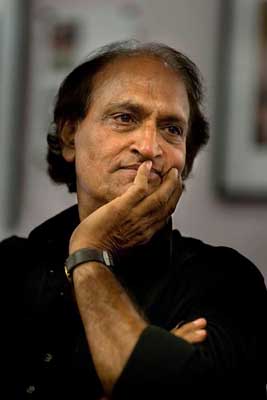 Raghu Rai ? Shehabuddin/Drik/Majority World
Raghu Rai ? Shehabuddin/Drik/Majority World
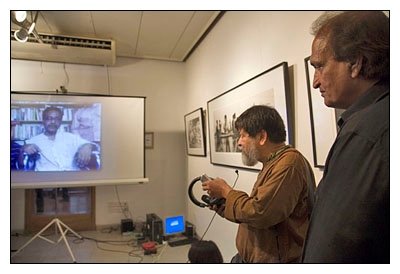 Professor Anu Muhammad opening Raghu Rai's exhibition "India" through Video Conference. ? Hassan Bipul
Professor Anu Muhammad opening Raghu Rai's exhibition "India" through Video Conference. ? Hassan Bipul
Review at New Age 0n 8th September 2009:
Raghu Rai?s ?India? at Bengal Gallery
Khairul Amin
Magnum photographer Raghu Rai?s photography exhibition ?India? began at Bengal Gallery of Fine Arts in Dhanmondi on Monday.?The exhibition, inaugurated by professor Anu Muhammad, will remain open from 11:00am to 7:00pm till September 13.?Around 54 photographs are put on display in the exhibition. The photographs were taken from all over India.?Professor Anu Muhammad inaugurated the exhibition by live conference as of he was unable to attend due to his hospitalisation. Artist and Chittagong University teacher Dhali Al Mamoon was present at the inaugural session.?Pathshala-South Asian Institute of Photography?s founder and principal Dr Shahidul Alam presided over the inaugural ceremony.
Raghu Rai shared his experience when he travelled for photography with the audience at the event and he encouraged the photographers by talking about different aspects of photography.??Rai is a talented photographer and a member of Drik Family, we are grateful to him for attending on the occasion of 20th founding anniversary of Drik?, said Dr Alam. He further said that the students of photography can learn so many things from this exhibition. ?I have just captured the life of the people of India and I have presented a part of my works in this exhibition. I have tried to uphold the multi-cultural India that is rather unknown to the viewers of other nations?, said Rai.?The photographer further said that he had clicked the moments in perfect time and he got the magical images.
A large number of people gathered in the inauguration of Rai?s exhibition.??Photographs of the exhibition have presented the untold stories of the people of India and I have learnt the method of simple presentation from this exhibition?, said Wahid Adnan, a student of Pathshala.
Maoists attack Nepal Times
Around 50 Maoist party supporters took part in yesterday?s attack on Himal Media, ransacking its offices and injuring CEO Ashutosh Tiwari and Kunda Dixit, the editor of one of its publications, the English-language Nepali Times.
The raid appears to have been prompted by an article in the Nepali Times and in another of the group?s publications, the Nepalese-language fortnightly, Himal Khabapatrika, accusing certain Maoist party activists of ?extremist behaviour,? interfering in business interests and threatening the media.
A member of the Himal Media staff said the assailants stormed into the group?s premises, hitting employees and warning that ?anything could happen if one of the group?s newspapers published anti-Maoist reports again.?
Dixit said: ?These people appeared to be martial arts experts, they had military training. It was an attack not just on Himal Media but on democracy and the media in particular, which the Maoists are doing everything possible to control.?
Maoist activists previously attacked Himal Media distribution depots in the capital on 16 November, vandalising equipment and torching more than 1,000 copies of Himal Khabapatrika in the street outside.
Kunda Dixit is one of the guest speakers at the upcoming opening of Chobi Mela.
Hajis Return to Bangladesh
[caption id="attachment_2073" align="aligncenter" width="600" caption="Undeterred by the shortage of trolleys at Zia International Airport, due to the huge influx of pilgrims returning from Hajj, one Haji makes her own arrangements. 15th December 2008. Dhaka. Bangladesh. ? Shahidul Alam/Drik/Majority World"] [/caption]
[caption id="attachment_2101" align="aligncenter" width="600" caption="Hajis at Zia International Airport on their way out. Shahidul Alam/Drik/Majority World"]
[/caption]
[caption id="attachment_2101" align="aligncenter" width="600" caption="Hajis at Zia International Airport on their way out. Shahidul Alam/Drik/Majority World"] [/caption]
[/caption]
| Photojournalist Kumara passes away
|
| (I just received news from my friend Panduka de Silva that my former student Kumara Dayawansa passed away). |
| Top Daily Mirror photojournalist Kumara Dayawansa Nannetti died last afternoon after suffering a severe heart attack. Kumara aged 47 at the time of his death was a versatile photojournalist who specialized in news, sports and fashion photography. Educated at Pannipitiya Dharmapala Vidyalaya, Kumara followed several photographic courses and joined the Wijeya Newspapers Limited in 1987 and began his media career at The Sunday Times. At The Sunday Times, Kumara specialized in news photography under the guidance of its founder Editor Vijitha Yapa and then News Editor Lalith Allahakoon. Kumara was the first Sri Lankan photojournalist to receive the Reuter?s Willie Vicoy fellowship which gave him the opportunity to study photojournalism at the University of Missouri in the United States. Kumara joined the Daily Mirror in 2000 and continued to contribute regularly to the newspaper. His colleagues remember Kumara for his good humor, simple ways, dedication and especially for some of his remarkable photographs that adorned the front pages of The Sunday Times and Daily Mirror. Kumara leaves behind his wife Veronica and two sons. His mortal remains will lie at No: 163/5, Wattegedara road in Maharagama. Funeral arrangements will be notified later |
Finalist in Aftermath Photography Contest
Saiful Huq Omi (Bangladesh) ? "The Disowned and the Denied: the Rohingya Refugees in Bangladesh"
Two images from Saiful Huq's application: [caption id="attachment_2025" align="aligncenter" width="600" caption="Jossna Ara Begum had everything. A family and some arable land. One night the river swallowed everything. The house, the land, and all the belongings. Her husband left home to find work and never came back. Everyday when she looks at her four starving children, Jossna wants to commit suicide. ? Saiful Huq"] [/caption]
[caption id="attachment_2026" align="aligncenter" width="600" caption=""We are a family of ten members- my parents and eight of our brothers and sisters. Before the attack, I used to work at the graveyard with my father. My father is a caretaker of a government owned graveyard. Though even before the attack, me and my father didn't earn decent enough, we knew at least we won't starve to death. Now, without me as an earning member, sometimes we do not have enough money to eat three times a day" says Rajib. ? Saiful Huq"]
[/caption]
[caption id="attachment_2026" align="aligncenter" width="600" caption=""We are a family of ten members- my parents and eight of our brothers and sisters. Before the attack, I used to work at the graveyard with my father. My father is a caretaker of a government owned graveyard. Though even before the attack, me and my father didn't earn decent enough, we knew at least we won't starve to death. Now, without me as an earning member, sometimes we do not have enough money to eat three times a day" says Rajib. ? Saiful Huq"] [/caption]
[/caption]
A historic verdict
New Age Editorial on 6th December 2008
THE verdict that the High Court delivered, in disposal of a public interest litigation writ petition on December 4, declaring illegal and void four provisions of the Emergency Powers Ordinance 2007 and the Emergency Powers Rules 2007, and the concomitant observation that the state of emergency cannot continue for an indefinite period in a people?s republic, in our view, constitute a benchmark in the country?s judicial history. The verdict and the observation also confirm what we at New Age and the politically conscious and democratically oriented sections of society have maintained all along, i.e. the military-controlled interim government has used the state of emergency largely as a convenient excuse to bypass the constitutional safeguards and equip itself with sweeping authority. The High Court, through its verdict and observation, has sent a clear message to the powers that be that enough is enough, and that the executive ? elected or unelected, interim or caretaker ? has no authority whatsoever to interpret at will the provisions laid out in the constitution of the republic. One need not be a jurist to understand that the emergency provisions in question are antithetical to democratic principles and jurisprudence. In a democratic dispensation, the executive branch of the state, i.e. the government, is only the implementer of laws enacted by the legislative, i.e. the national parliament while the judiciary is entrusted with the authority to make sure the laws enacted by the parliament and executed by the government are consistent with, and do not encroach upon the freedom guaranteed by, the constitution. Section 5 of the emergency ordinance and 11 (3) of the emergency rules are clearly violative of the constitutional scheme of the republic; certainly, it cannot be up to the executive to decide whether or not its order can be challenged in the court of law or whether or not the appellate court can stay the verdict of a lower court or hear the bail petition of an accused. On the other hand, emergency rules 19 (Gha) and (Uma) confiscate the rights of the accused, the rights to be treated as innocent until proven guilty, the rights to seek bail for offences that are bailable under the ordinary law of the land and the rights to challenge move the appellate court against verdicts delivered by a lower court. Emergency Rule 18 (Ka), which empowered the Anti-Corruption Commission to transfer any corruption case from any court to special judge?s court, also sought to establish the executive?s primacy over the legal system in general and the higher judiciary in particular. The High Court, by stripping the commission of the power entrusted upon it by the rule, has rightly put its foot down and drawn the line for the government. To recapitulate, the High Court?s verdict and observation sends the clearest message ever to the interim government, that it has outlived its stay and overshot its mandate. We would rather that the incumbents did not appeal against the verdict. Instead, they should apologise unconditionally for its constitutional misdemeanour and pay up for the damage its unconstitutional errands have caused to the people.---------------------------------------------------------------------------------------------------------------------------------------------
 [/caption]
Thursday 4 December 2008
6.30-8.30pm
Shoreditch Gallery, 5 Hoxton Market, Shoreditch
London N1 6HG
Phone +44(0) 20 7619 0960
Nearest Tube
Old Street & Liverpool Street
Buses: 35, 47, 48, 55, 67, 135, 149, 242, 243
Chand Aftara in association with Shoreditch Gallery is pleased to announce an exhibition of photography,
film and installation by the emerging artist Sunara Begum in her debut Solo exhibition entitled Ara's World.
Begum's powerful imagery evokes deep-rooted feelings of reflection, contemplation and stillness. In her three short films, accompanying photography and installations she continues to develop themes of
striking imagery that transcends the confines of form.
*Special performance by Shahanara Begum & Tunde Jegede
[/caption]
Thursday 4 December 2008
6.30-8.30pm
Shoreditch Gallery, 5 Hoxton Market, Shoreditch
London N1 6HG
Phone +44(0) 20 7619 0960
Nearest Tube
Old Street & Liverpool Street
Buses: 35, 47, 48, 55, 67, 135, 149, 242, 243
Chand Aftara in association with Shoreditch Gallery is pleased to announce an exhibition of photography,
film and installation by the emerging artist Sunara Begum in her debut Solo exhibition entitled Ara's World.
Begum's powerful imagery evokes deep-rooted feelings of reflection, contemplation and stillness. In her three short films, accompanying photography and installations she continues to develop themes of
striking imagery that transcends the confines of form.
*Special performance by Shahanara Begum & Tunde Jegede
Cartoon Against Corruption
Exhibition arranged by Transparency International
at Drik Gallery (map)
 [/caption]
[/caption]
Khaled Hasan runner up at Labour Day Photo Contest
[caption id="attachment_1657" align="aligncenter" width="500" caption="Khaled Hasan of Pathshala runner up at Labour Day Photo Contest"] [/caption]
[/caption]
[caption id="attachment_1659" align="aligncenter" width="397" caption="The first ever LabourStart Labour Photo of the Year contest. Judging took place by popular vote."] [/caption]
[/caption]
Asia Pacific Premiere
Every Good Marriage Begins With Tears
UK 2006 / 62min. Director Simon Chambers
Two Bangladeshi girls born and raised in London agree to allow their parents to choose their husbands for them. The elder, Sahanara, quick-witted, coarse-mannered and the rebel of the family, banished from the family in her teens for being "too Western", has to swap her pink hot pants for a sari as she goes off to the airport to meet her new Bangladeshi husband. The younger, Hushnara is more submissive, devout and accepting of her father?s match with stoic dutifulness. Simon Chambers is an old friend of the family and the family is welcoming of his decision to film the family. The film is intimate, surprisingly frank and revealing of British Muslim life not normally seen. The family regularly address him directly or ask his opinion during a domestic dispute, which he then gives in the voice-over. Simon starts filming just before Sahanara?s bridegroom arrives in Great Britain. At that point, everything still seems all right. But when Simon drops by a few months later, the household is in an upheaval. Sahanara has left her husband; found a job and a new boyfriend while Hushnara has doubts about her pending nuptials. Eventually, Chambers accompanies the family to Bangladesh for Hushnara?s wedding, and to look for Sahanara, who has disappeared completely. Feeling more like an independent dramatic feature film than a documentary, it is beguiling and captivating. It is a timely antidote to the current media preoccupation with Islamic religious fundamentalism, terrorism or "how badly they treat their women". Part 1: http://www.veoh.com/videos/v15312897HsHze6GG part 2: http://www.veoh.com/videos/v153129015nQnsgeK
source: Robin Khundkar--------------------------------------------------------------------
Photographer profile
1 October 2008
Third eye
Munem Wasif aims to raise consciousness around the world with his striking images of his Bangladeshi homeland. Diane Smyth meets him
 ? Munem Wasif/Agence VU
? Munem Wasif/Agence VU
----------------------------------------------------------------------------------------------------------------------------------------------------------------------------- Gallerie, The PEN All-India Centre, and Jnanapravaha
present
A Tribute to Mahmoud Darwish
In response to the Berlin International Literature Festival's appeal
for a worldwide reading of Mahmoud Darwish's poetry on October 5, 2008
Gallerie-PEN India-Jnanapravaha come together to commemorate the life and work
of the world-renowned Palestinian poet with an evening of readings.
*
Welcome by Rashmi Poddar.
A brief introduction to the poet's literary and political background by Bina Sarkar Ellias.
Readings of Mahmoud Darwish's poems by
Gieve Patel, Sampurna Chattarji, Prabodh Parikh, Yuki Ellias,
Anand Thakore, Arundhathi Subramaniam, Bina Sarkar Ellias.
Date: October 5th, 2008
Time: 6 pm
Directions:
If coming from V.T., Queens Mansion is on A. K. Nayak Marg i.e. the lane behind Khadi Gramodyog.
If coming from Churchgate then Jnanapravaha is above "Yantra" (a lifestyle store) on Prescott Road, which is the lane directly opposite J. B. Petit School. Queens Mansion is adjacent to Cathedral Middle School.
ALL ARE WELCOME
--------------------------------------------------------------------------------------- Dear Friends, In solidarity with STUDENTS AGAINST SEXUAL REPPRESSION of Jahangirnagar University (JU), a protest will be held today at 3.00 pm at TSC Road Island of Dhaka University. Prof. Sirajul Islam Choudhury, Anu Muhammad, Selina Hossen. Justice Golam Rabbani, Akmol Hossen, Giti Ara Nasrin, Kaberi Gayen and ex and contemporary students of JU will join the meeting. Please do come. Faruk Wasif ---------------------------------------------------------------------------------------- I have no way of verifying the authenticity of the following initiative. I have been sent this letter and am making the information available. Please check things yourself to ensure that your work will be used properly. Shahidul Environmental Images
Environmental Images is an online platform for displaying environmentally focused photography by local photographers documenting their local issues.
We are searching for local photographers engaged in documentary work centered around environmental issues. Photo-essays may relate to social issues tied to environmental degradation or may focus on positive initiatives such as preservation, conservation, community responses to environmental degradation, as well as the impacts of unregulated globalization.
Environmental Images is a non-profit with the goal of highlighting exceptional environmental photography by local photographers. The copyright of all participating photographers will be protected and although we aim to enhance your sales, we do not take any percentage. All organizations and image buyers interested in your work will be directed to you, the photographer. If you are a photographer with a body of work about environmental issues, please send us low-resolution images, accompanying text including locations and a short biography about yourself. If you are chosen for the project you will be given an online gallery space and profile page. We will then promote your work to environmental non-profits and image buyers throughout the world.
Please ask any local photographers documenting these issues to email submissions to: submissions@environmentalimages.org
Thank you for your support.
Sincerely,
?
Tom Dooley
posted on 12th September 2008
----------------------------------------------------------------------------------

-----------------------------------------
Curfew still in force in Kashmir
Many parts of the Indian state of Jammu and Kashmir are still under curfew as authorities try to halt huge protests by both Muslim separatists and Hindus.
BBC report by Damian GrammaticasIndian police are still holding separatist leaders who were arrested on Sunday and Monday after they defied the curfew and attempted to lead protests.
Five people have been shot dead while trying to protest in the past two days. The restive Himalayan state is seeing some of the biggest protests against Indian rule in at least 20 years. In the Kashmiri city of Srinagar, the streets are deserted. Armoured cars are on patrol and there are road blocks on all key routes in the city. Three senior political leaders of pro-separatist parties are under arrest to prevent them leading street protests. Meanwhile, a curfew is also in force in some of the Hindu majority areas around the city of Jammu as Hindus have also been staging their own demonstrations in recent months. In the past two weeks, at least 27 people have been shot dead and 500 injured, as security forces try to restore order in the Muslim majority area. Photographs by Imran Ali Women try to find food for their families as home stocks run out after the third day of curfew. Srinagar. Kashmir. India. 26th August 2008. ? Imran Ali/KT Photo/Majority World
Women try to find food for their families as home stocks run out after the third day of curfew. Srinagar. Kashmir. India. 26th August 2008. ? Imran Ali/KT Photo/Majority World
 Patients in City Hospital in Srinagar, who were injured by police firing on the 25th August 2008 at Hajan. Srinagar. Kashmir. India. 26th August 2008. ? Imran Ali/KT Photo/Majority World
posted on 26th August 2008
----------------------------------------------------------------------------------
Patients in City Hospital in Srinagar, who were injured by police firing on the 25th August 2008 at Hajan. Srinagar. Kashmir. India. 26th August 2008. ? Imran Ali/KT Photo/Majority World
posted on 26th August 2008
----------------------------------------------------------------------------------
Will Army Intervene To "Stabilize" Country Under "Mentally Unstable" President?
Financial Times, UK August 25 2008 23:31 Doubts cast on Zardari?s mental health By Michael Peel in London and Farhan Bokhari in Islamabad Asif Ali Zardari, the leading contender for the presidency of nuclear-armed Pakistan, was suffering from severe psychiatric problems as recently as last year, according to court documents filed by his doctors. The widower of former prime minister Benazir Bhutto was diagnosed with a range of serious illnesses including dementia, major depressive disorder and post-traumatic stress disorder in a series of medical reports spanning more than two years. Mr Zardari, the co-chair of the Pakistan People?s party, and its candidate to succeed president Pervez Musharraf, who stepped down last week, spent 11 of the past 20 years in Pakistani prisons fighting corruption allegations, during which he claims to have been tortured. While Mr Zardari was not available to comment, Wajid Shamsul Hasan, Pakistan?s high commissioner to London, speaking on his behalf, said he was now fit and well. News of his medical records came as Nawaz Sharif, head of the junior partner in the government, pulled his party out of the coalition, partly because of differences over Mr Zardari?s presidential candidacy. In court documents seen by the Financial Times, Philip Saltiel, a New York City-based psychiatrist, said in a March 2007 diagnosis that Mr Zardari?s imprisonment had left him suffering from ?emotional instability? and memory and concentration problems. ?I do not foresee any improvement in these issues for at least a year,? Mr Saltiel wrote. Stephen Reich, a New York state-based psychologist, said Mr Zardari was unable to remember the birthdays of his wife and children, was persistently apprehensive and had thought about suicide. Mr Zardari used the medical diagnoses to argue successfully for the postponement of a now-defunct English High Court case in which Pakistan?s government was suing him over alleged corruption, court records show. The case ? brought to seize some of his UK assets ? was dropped in March, at about the same time that corruption charges in Pakistan were dismissed. However, the court papers raise questions about Mr Zardari?s ability to help guide one of the world?s most strategically important countries following the resignation last week of Mr Musharraf, under whose rule the corruption cases against the PPP leader and his late wife, Benazir Bhutto, were pursued. Mr Zardari and Ms Bhutto, who was murdered in December while leading the PPP in elections that gave it the most seats in Pakistan?s parliament, were also the target of corruption investigations in Switzerla nd and Spain. The Geneva prosecutor said on Monday that money laundering charges against Mr Zardari were being dropped. Mr Hasan, a long-standing political ally and friend of the Zardari/Bhutto family, told the Financial Times on Monday that Mr Zardari had subsequent medical examinations and his doctors had ?declared him medically fit to run for political office and free of any symptoms?. ?You have got to understand that while he was in prison on charges that were never proven, there were attempts to kill him,? Mr Hasan said. ?At that time, he was surrounded by fear all the time. Any human being living in such a condition will of course suffer from the effects of continuous fear. But that is all history. ?In fact, many people were very impressed to see Mr Zardari go through the trauma of the assassination of Benazir Bhutto, but still hold himself together, hold his family, especially his children, close to him at this very difficult time.? posted by Robin Khundkar on 26th August 2008 ------------------------------------------------------------------------------------Educational Achievements of Pakistani Presidents
Current President of Pakistan Mohammedmian Soomro Mr. Mohammedmian Soomro was born on August19, 1950 and earned a B.Sc. degree with distinction from the Forman Christian College, Lahore. He obtained Master's in Physics from the Punjab University, Lahore, followed by another Master's in Operations Management from the Northrop University, USA. Northrop University From Wikipedia, the free encyclopedia Northrop University was founded in 1942 by Jack Northrop of Northrop Aviation. Originally named the Northrop Aeronautical Institute, the school opened for classes in June of 1946 to 412 students committed to and/or already employed by Northrop Aviation. The school was founded by Jack Northrop for the purpose of training aeronautical engineers and mechanics. Due to financial difficulties the school became independent from the Northrop Aircraft corporation in 1953 and the name of the school changed to The Northrop Institute of Technology. Unfortunately, the fate of the university did not fare much better and again closed its doors in 1970. In 1971, the University again opened its doors and as Northrop University. Administered by previous alumni and faculty, the University offered bachelors and masters degree programs in aeronautical sciences, civil, electrical and mechanical engineering, computer science and design engineering project management. In 1975 the school received a large donation from its original founder to build the American Hall of Aviation. The museum enjoyed great notoriety from its housing of the David D. Hatfield collection of aviation history; by far the largest collection of aviation history to ever be displayed at any one location. In August of 1993, Northrop University closed its doors to the public. Mismanaged funds, decreased attendance and donations crippled the university in to bankruptcy. The universities door remain closed today though the campus still exists in Inglewood, California. Future President Scotland on Sunday Zardari ready to take reins in Pakistan Published Date: 16 March 2008 By Jane Perlez in Islamabad In the early 1970s, Zardari went to London. There, Zardari said in the interview, he attended the London School of Business Studies and received a degree. His official biography says he attended a commercial college called Pedinton School. But a search of tertiary educational institutions in London showed no such school, and associates said he did not finish his studies. Zardari said: "I do have a degree. That is not an issue. I attended the London School of Business Studies much before I was married. I think it's a B Ed degree. I haven't really looked at it." One has yet to come across a person who is not sure what his degree was in. He hasn't even bothered to look at it. With a B Ed the new President could do for school education what Prof Ataur Rahman did for higher education ? ruin it further! [this is not part of the Perlez text] posted by Abdus Salam on 26th August 2008------------------------------------
Protests and repression continue in Kashmir.
More photographs by Imran Ali
Paradise Found: Story on Kashmir By Salma Ali and Shahidul Alam
Posted on 24th August 2008 Bilal Bhat Bureau Chief of Sahara Television being taken to hospital after being beaten by Security Forces. Srinagar. Kashmir. India. 24th August 2008. ? Imran Ali/KT Photo/Majority World
Bilal Bhat Bureau Chief of Sahara Television being taken to hospital after being beaten by Security Forces. Srinagar. Kashmir. India. 24th August 2008. ? Imran Ali/KT Photo/Majority World
 Journalists in silent protest against the attack on Bilal Bhat by Security Forces in Srinagar, in which around a dozen journalits were injured. Srinagar. Kashmir. India. ? Imran Ali/KT Photo/Majority Worl
Journalists in silent protest against the attack on Bilal Bhat by Security Forces in Srinagar, in which around a dozen journalits were injured. Srinagar. Kashmir. India. ? Imran Ali/KT Photo/Majority Worl
--------------------------------------
City of Perpignan Young Reporter?s Award!
Dear Friends, I am so thrilled to give you the news that I have selected this year ?City of Perpignan Young Reporter?s Award 2008? at VISA POUR L?IMAGE . There will be an exhibition of mine in ?THE COUVENT SAINTE CLAIRE?, link for the map from 30 August to 14 September. Here is the a link of my work Regards, Munem Wasif 17, boulevard Henri 4 75004 Paris ? France Tel: +33 1 53 01 85 85Fax: +33 1 53 01 85 80
posted on 23rd August 2008 --------------------------------------------------------------------------------------Hussain excluded from India Art Summit
Side Gallery, Newcastle-upon-Tyne
An Autograph ABP exhibition in partnership with Shahidul Alam and Drik Picture Library
Outside the Bangladeshi community, the details may have been forgotten by many people in the UK, but the traumatic events of the country?s war of independence continue to haunt its sense of identity. In an attempt to crush independence forces in what was then East Pakistan, the West Pakistani military regime unleashed a systematic campaign of violence that resulted in the deaths of thousands. The exhibition, drawn from the unique Drik photographic archive, documents this harrowing and bloody conflict, bringing together images taken by local photographers, including Golam Mowla, Aftab Ahmed, Rashid Talukder, Jalaluddin Haider, Mohammed Shafi, Mukaddes Ali, Bal Krishnan, Abdul Hamid Raihan and Naib Uddin Ahmed.
Free public talk by Shahidul Alam, co-curator, introduces Bangladesh 1971, 6pm, 2 September.
VENUE - Please contact directly for more details
Review of the premiere in London
---------------------------------------------------
More Kashmir Photos by Imran Ali.
Paradise Found: Story on Kashmir By Salma Ali and Shahidul Alam
Posting on 18th August 2008
March to UN Office: Hundreds of thousands of people from all over Kashmir valley assembled at the Tourist Reception Centre (TRC) ground before many groups submited a memorandum at UN oofice at Sonwar in Srinagar. 18th August 2008. Kashmir. India. ? Imran Ali/KT Photo/Majority World
Convoy of motorbikes head to Pampore town. Thousands of people streamed through the streets of Kashmir on Saturday on the Srinagar-Jammu national highway, to pay homage to senior Hurriyat leader Sheikh Abdul Aziz and 21 others killed in the past few days by Security Forces during Muzzafarabad march. 16th August 2008. Kashmir. India. ? Imran Ali/KT Photo/Majority World
Security Forces assault protestors in Srinagar soon after demosntrations in the area. 13th August 2008. Kashmir. India. ? Imran Ali/KT Photo/Majority World
Police firing towards protesters during protest demonstration in Srinagar. 13th August 2008. Kashmir. India. ? Imran Ali/KT Photo/Majority World
Thousands of people break curfew to participate in funeral procession of separatist leader Shiekh Abdul Aziz who was killed by police firing in Uri the previous day. 12th August 2008. Kashmir. India. ? Imran Ali/KT Photo/Majority World
Posting on 6th August 2008
Tyres burnt by protesters on the middle of main roads at Karan Nagar against the killing of a boy in Srinagar. 6th August 2008. Kashmir. India. ? Imran Ali/KT Photo/Majority World
Residents of Bemina in Srinagar protesting aginst the Shiv Sena activists who critically injured Lateef Ahmed driver at Lakhanpur. 6th August 2008. Kashmir. India. ? Imran Ali/KT Photo/Majority World
Pitched battle despite curfew, between protestors and police, on second consecutive day following the killing of a boy at Maisuma in Srinagar. 6th August 2008. Kashmir. India. ? Imran Ali/KT Photo/Majority World
Protesters in action at Nowhatta, despite curfew after the kiling of a boy at Maisuma in Srinagar. 6th August 2008. Kashmir. India. ? Imran Ali/KT Photo/Majority World
-------------------------------------------------
Young boy Asif killed by police in Srinagar. 4th August 2008
Pictures by Imran Ali
 Protesters and policemen fighting after the killing of a boy Asif, at Maisuma in Srinagar on Monday. 4th August. Kashmir. India. ? Imran Ali/KT Photo/Majority World
Protesters and policemen fighting after the killing of a boy Asif, at Maisuma in Srinagar on Monday. 4th August. Kashmir. India. ? Imran Ali/KT Photo/Majority World
Protester attacking policeman after they fired tear gas shells on Asif's coffin during the funeral at Maisuma in Srinagar. Kashmir. India. ? Imran Ali/KT Photo/Majority World
 Asif's relatives wailing over his body. He was killed by police during protests at Maisuma on Monday 4th August 2008. Srinagar. Kashmir. India. ? Imran Ali/KT Photo/Majority World
Asif's relatives wailing over his body. He was killed by police during protests at Maisuma on Monday 4th August 2008. Srinagar. Kashmir. India. ? Imran Ali/KT Photo/Majority World
 Protesters including Mohammed Yasin Malik and Nayeem Khan, carrying the coffin of Asif who was killed by police during protests at Maisuma on Monday 4th August 2008. Srinagar. Kashmir. India. ? Imran Ali/KT Photo/Majority World
Protesters including Mohammed Yasin Malik and Nayeem Khan, carrying the coffin of Asif who was killed by police during protests at Maisuma on Monday 4th August 2008. Srinagar. Kashmir. India. ? Imran Ali/KT Photo/Majority World
 Thousands of people including various seperatist leaders during the funeral of young boy Asif who was killed by police during the protests at Maisuma on Monday 4th August 2008. Srinagar. Kashmir. India. ? Imran Ali/KT Photo/Majority World
Thousands of people including various seperatist leaders during the funeral of young boy Asif who was killed by police during the protests at Maisuma on Monday 4th August 2008. Srinagar. Kashmir. India. ? Imran Ali/KT Photo/Majority World
----------------------------------------
"Majority World": UCLA's Amerasia Journal Publishes New Thinking on Post 9-11 Culture and Crisis
Los Angeles-The UCLA Asian American Studies Center announces the thirty-seventh-year Spring 2008 edition of Amerasia Journal, which focuses on post 9-11 identity and culture through the concept of "majority world." This issue is entitled "Majority World Movements," a term coined by Bangladeshi photojournalist and scholar Shahidul Alam. In the early 1990s, Alam began to advocate for a new expression, to, in his words, challenge the "West's rhetoric of democracy." (During the past forty years, " the culture of poverty," and "third world communities" were used domestically, while internationally, countries were categorized as Third World, Developing World, or as Least Developed Countries.)
However, as Alam points out, "the expressions have strong negative connotations that reinforce the stereotypes about poor communities and represent them as icons of poverty." Thus, the term "majority world" seeks to define "the community in terms of what it has, rather than what it lacks." The term necessarily includes the cultural, intellectual, and social "wealth" of these communities.
Alam believes that the contemporary photographic image has the "power to validate history" from the majority world perspective, in opposition to manufactured corporate representations. To challenge such media power brokers, in 1994 Alam began to teach photojournalism to working-class children in Dhaka, enabling them to become the producers and disseminators of their own images.
Majority World explores both the concept and its implications with contributions by an international array of scholars, writers, and activists in the following three sections.
Part One-Articles in this section include: "Form and Emptiness: Globalization, Liberalism and Buddhism in the West," by Dana Takagi, who looks behind the culture of Buddhism in the U.S.-in relation to the popular traffic of both ideas and things-books, statues, malas, incense, prayer flags. In the West, as Takagi argues, Buddhism can also, contribute to the formation of new political movements including "ecopolitics, cultural politics, ethical advocacies, and radical autonomy."
Constance J. S. Chen, in her study, "'The Esoteric Buddhist': William Sturgis Bigelow and the Culture of Dissent," examines the late nineteenth-century trend of American Orientalism "amidst the dramatic socioeconomic transformations taking place on both sides of the Pacific."
Chinese American writer Maxine Hong Kingston works with American War veterans through her writing workshops that combine her writing expertise, Buddhist theory and practice, and notions of sangha or community from various wars, according to Shan Te-hsing who interviewed Kingston. Kingston states: "A veteran can be a peace activist, a woman, a deserter, a combat soldier, a non-combatant, et cetera."
Nancy Abelmann and Shanshan Lan, in this section, examine an Asian American campus church predominately made up of Korean and Taiwanese Americans; Brandy Lien-Worrall, our book review editor based in Vancouver, Canada, contributes a Zen poem.
Part Two of this special issue focuses on South Asia, with featured commentary on the culture and countries involved in the political assassination of Benazir Bhutto, who had returned to Pakistan in the Fall of 2007. These include writings by Roshni Rustomji, Vinay Lal, and Amitava Kumar.
Part Three features new research. Jane Mee Wong examines Pingshe-the Equality Society and the writings of Ray Jones, or Liu Zhongshi, a Chinese American worker and main organizer of the U.S. branch of the China-based anarchist group. Wong utilizes the Chinese American archives developed by Him Mark Lai at U.C. Berkeley. See also William Gow's excerpt of the memoir of his grandfather's sister, Auntie Kay, from her life growing up in China Alley in Oxnard, California in the years before the 1965 Immigration Act. Will, a social historian and a graduate of the M.A. program in Asian American Studies at UCLA, also provides an additional research note on how to do Asian American genealogical research utilizing family records, family trees, timelines, and new technologies.
